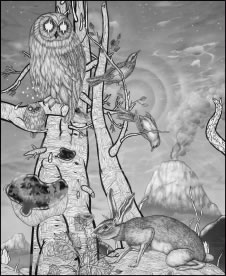BY STEPHANIE BUHMANN
Audubon denizens: awaiting Apocalypse or regeneration?
In the new exhibition “Forgotten Planet,” Jon Rappleye continues his exploration of imaginary landscapes both familiar and otherworldly. The fusion of pre-historic and futuristic elements describes, according to Rappleye, places “of uncertainty and of the in-between, which remain mysterious and provoke questions of place, time, nature, and our relationship to it and its inhabitants.”
Arrays of meticulously rendered animals — ranging from owls to deer, peacocks and bats — inhabit strangely mesmerizing worlds, creating a sense of anticipation. Collected into vivid groups, they become silent spectators as volcanoes erupt, streams of water push by, and single leafs cling to almost barren trees. Some animals appear frequently; and to Rappleye, the owl above all has a special meaning. “As a child, I was always drawing owls and making sculptures from small rocks. I once painted a large rock maybe two feet tall, which my father helped me hoist up into the crook of a dead tree stump. The owl, for me, embodies the mysteries of the unknown and unseen. It is a mythical creature, which can also stand for the creator and the artist.”
Rappleye has always enjoyed folklore and mythologies, and he is fascinated with how different cultures have various meanings for animals. His interest in the Native American White Deer Prophecy is reflected in the themes of his own work (nature, destruction, salvation and restoration). For Rappleye, nature always seems on the verge of monumental change — and it is unclear if this will manifest in the form of an apocalypse or regeneration.
Compositionally, Rappleye’s new body of work adds a twist. Moving away from more monotone, graphic backgrounds, he now employs complex landscapes (such as dramatic mountain ranges and cloud formations). They exude a strong science fiction quality, lingering between the sublime and inevitable doom. Rappleye explains this development with his new interest in three-dimensional work, which was sparked while he was at the John Michael Kohler Arts in Residency program in Sheboygan, Wisconsin. It was this foray into the three-dimensional that influenced his two-dimensional work. He reflects: “The space became deeper, much more illusionist, and atmospheric. I think that seeing things in the round helped me to depict a more fully realized world in the paintings as well. I often think that the skies, for example, convey a brief moment before or after some cataclysmic event. They are beautiful and yet, also somewhat threatening in their severity of color and form.”
Rappleye’s work thrives on contrasts. While the living creatures are exclusively rendered in black and white, bringing medieval etchings to mind, the backgrounds are captured in vivid colors. His line is meticulous and his sources of inspiration manifold. “I really like Audubon because of the attention to detail. These drawings are scientific and informational, explaining visually what each creature looked like. This is the kind of depiction that I am interested in and it draws attention to the animals in contrast to the other elements.”
Rappleye also works from books, magazines and photographs, some of which he takes in zoos. Most importantly, “I also work from my imagination, creating hybrids of animals or, as seen recently, combinations of animals and plant and tree fragments,” he explains. “I have had some great opportunities to observe and photograph animals in nature, be it at my family’s home in rural Utah or at artist residencies in Jentel, Wyoming or Headlands in Sausalito.”
The backgrounds against which the animals and plant life are set, aid in creating a heightened sense of depth. They also establish an atmosphere that seems filled with anxiety and unease. That notion is enhanced with Rappleye’s choice of including occasional fragments of the human skeleton in these new compositions. The idea of hinting at a human presence (albeit while depicted in death) originated last year — when Rappleye was working on a project for Richard Heller Gallery in Los Angeles. “I felt the need to introduce evidence of a human presence in the shape of deforestation, for example,” he states, in order to address “issues of the environment and our precarious relationship with it.”
An innovative mix of styles and influences characterizes Rappleye’s work. His use of line for example reminds of medieval woodcuts and Japanese animé, while his renditions of the animals bring Northern Renaissance masters, such as Albrecht Dürer to mind. In a way, Rappleye’s work is “a hybrid of different styles and influences.” “I never could work in just one way,” Rappleye explains. “I would draw something this way here and then, change media, and paint something else over there. It’s just a natural way for me to work. I have always had a fondness for Asian art and its lines are so graceful and poetic. The landscapes, which are often in black and white, have this dynamic quality with the almost alien rough terrain.”
When referring to the new body of work, he cites many influences, ranging from “the cold bleak skies of Pieter Bruegel’s melancholic winter scenes” to Thomas Moran, Lee Mullican, Charles Burchfield, Albrecht Altdorfer, and Salvador Dali. Rappleye adds that his work also “combines an interest in science and technology. There is a sense of artifice based on my interest in the divide between the natural and the manmade; and I see elements of ‘The Wizard of Oz’ and Dr. Seuss.”
There is as much joy in Rappleye’s work as there is melancholy. In the end, he leaves us pondering about life’s fragility and hints at the fact that with this realization there will also come hope. He grew up on a small farm in rural Utah, where the family raised chickens, rabbits, geese and ducks. When moving east, he recalls that he “missed the mountains greatly,” and though the skyscrapers have since replaced them, Rappleye’s work is good evidence that he “still misses the big wide-open skies…”

































